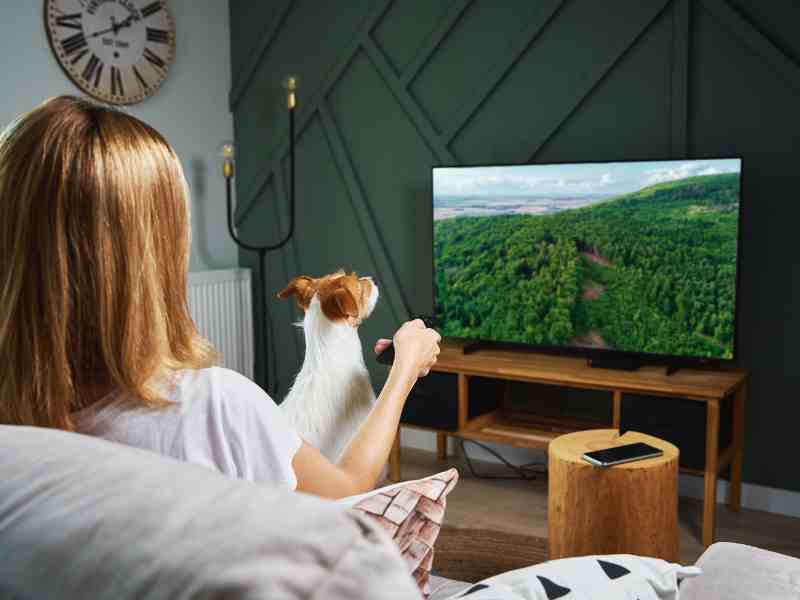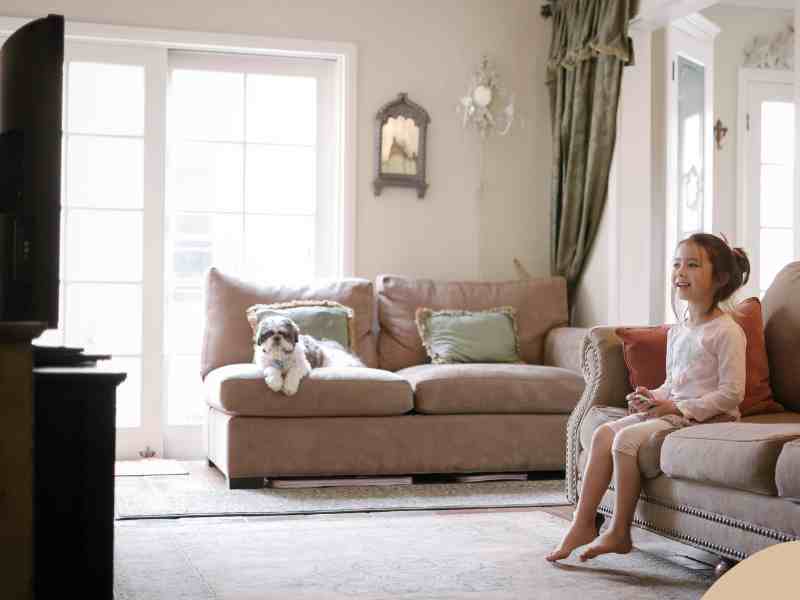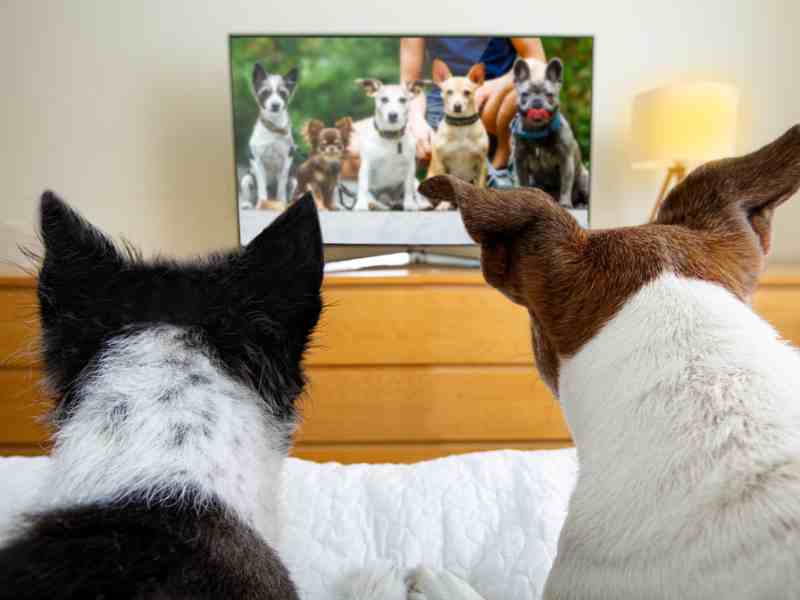Have you ever caught your dog staring at the TV like it’s the final episode of their favorite show? Believe it or not, it’s a pretty common sight in TV rooms worldwide. There’s your dog, parked in front of the screen, eyes tracking every move, maybe even barking at that cartoon squirrel that just won’t quit. Sure we laugh, but we have to also wonder… what’s going on in their furry heads? Are they actually following the plot, or is it just the lights and sounds grabbing their attention?
Do Dogs Watch TV?
Dogs and TV have a quirky relationship. Some dogs might seem totally indifferent, barely glancing at the screen, while others could be low-key binge-watchers, and even seem to have preferences for certain shows or commercials. They’ll tilt their heads like they understand, perk their ears at certain jingles, or even bark at other dogs, animals, or people on the screen. Behaviors like those are why we keep asking, “Is my dog watching TV?” and science suggests the answer may be, “Yes!”
What Happens When My Dog Watches TV?
When it comes to whether our furry friends can actually see what’s happening on TV, the science is fascinating and offers some clear insights. Dogs do see the world differently than humans. For starters, they have dichromatic vision, meaning they see in two primary colors – blue and yellow. This is a contrast to humans, who typically have trichromatic vision and can perceive a broader spectrum of colors. Despite this limitation, dogs are really sensitive to movement, which makes television an engaging experience for them.
The notion that dogs can’t see TV because it looks too blurry or because they can only see in black and white is pretty outdated. Modern research has shown that while dogs perceive fewer colors with less saturation than humans, their vision still pulls in dull blue, yellow, and green tones. This basically busts the myth that they only see in monochrome. Their unique vision, combined with their ability to detect motion and differentiate colors to some extent, allows them to respond to visual stimuli on screens, just as you or I would when watching.
The transition from older cathode-ray tube (CRT) TVs to modern high-definition and ultra-high-definition screens has also significantly made TV images more accessible to dogs. Older TVs had a flicker that was more noticeable to pets due to their ability to perceive flickering at higher speeds than humans. The higher refresh rates of modern screens mean images are less likely to flicker in a way that dogs can detect, which potentially makes the content more watchable for them.
Still, not all dogs are interested in TV, whether they can see it or not, and breed definitely plays a role. Sighthounds and terriers, for instance, are more likely to engage with moving images on a screen than scent-driven breeds like bloodhounds and beagles. This difference is tied to the dogs’ primary senses and hunting instincts. Breeds known for their visual acuity, like Greyhounds and Salukis, are more likely to see images on the TV clearly, whereas breeds with shorter snouts might struggle due to their limited field of vision.
Does My Dog Understand What’s Happening On TV?
Even though dogs can see TV and sometimes seem to be captivated by the action on screen, it’s important to remember that their comprehension of what’s happening is not the same as a human’s. They may recognize familiar shapes, movements, and sounds, which can make watching TV a stimulating experience. For instance, a dog might be drawn to a TV show featuring animals, responding to the movement and sounds of the creatures on screen. Auditory cues, in particular, play a significant role in how dogs interpret on-screen content, helping them connect what they see and hear.
Their unique visual and auditory senses shape their TV experience. This doesn’t necessarily mean they grasp complex narratives, but they do respond to the sensory stimuli of moving images and sounds, and may be getting more than we ‘think’ they get.
The Role of Sound in Attracting Dogs to TV
Sound is another crucial factor that can draw dogs to the TV. Dogs have a strong sense of hearing and can recognize familiar sounds, which might explain why they react to certain programs or commercials, even from across the house. The sound of other animals, particularly dogs barking or cats meowing, can also grab their attention. More, the noises of squeaky toys, doorbells, or cars can also prompt a response, because those are ones that they typically experience in their regular life.
Interestingly, the auditory cues from television can lead to their visual engagement. A dog might initially be drawn to the TV by the sound of a familiar animal or object but then continue to watch due to the movement and visual interest. This multi-sensory attraction shows how integrated visual and auditory stimuli are in capturing and holding dogs’ (and humans’!) attention when it comes to television watching.
What’s The Best TV For My Dog To Watch?
Dogs’ interactions with TV are usually brief, often lasting less than three seconds, indicating a preference for glancing at the TV rather than focusing on it intently. The best TV content for dogs would include lots of short clips that can capture their attention through movement. Despite these brief interactions, dogs do show a preference for watching other dogs on TV, especially when the programs are designed with colors that they can easily perceive, and you always have those dogs who definitely pay much longer attention to what’s on.
The thing is, though, while TV can serve as a source of entertainment for dogs, especially those left alone at home, it cannot replace the sensory richness of real-life interactions and outdoor activities. Although dogs can perceive visual media and show interest in it, their understanding of content lacks the depth of human comprehension, as they likely just don’t get the nuances and bigger narratives played out on the screen. It may be entertaining, but unless specific programming for dogs, like DogTV, they’re likely just watching for action and motion, not understanding.
TV programs and channels specifically designed for dogs, like DogTV, offer a unique blend of content specifically tailored to dogs’ visual and auditory preferences. These platforms feature programming that includes various types of stimuli, such as moving objects, animals playing, and calming visuals. DogTV, for instance, is designed based on scientific studies that understand what dogs see best, focusing on particular colors that dogs can easily distinguish, like blues and yellows. The content is also created to show scenarios familiar to dogs, providing both stimulation and relaxation, with sounds that appeal to them, including those of nature, toys, and other dogs.
Benefits of Letting Your Dog Watch TV
So, if your dog does watch, are there benefits to dogs watching television? Science suggests there are:
- Anxiety Relief: For dogs that experience separation anxiety or general nervousness, watching TV can offer comfort. The familiar sounds and sights can help soothe them, making them feel less alone.
- Stimulation: Dogs left alone for long periods might get bored, leading to destructive behavior. TV can provide mental stimulation, keeping their minds active and engaged.
- Company: The sound of human voices and other animals from the TV can provide a sense of company to dogs, making them feel like part of a pack or as if their human is still with them.
Precautions and Advice on Managing Screen Time for Dogs
But, just like in humans, while there are benefits to letting dogs watch TV, it’s essential to manage their screen time effectively:
- Not a Substitute for Human Interaction or Exercise: TV should not replace physical activity or human interaction. Dogs need regular exercise and direct engagement with their owners to stay healthy and happy.
- Monitor Their Reaction: Pay attention to how your dog reacts to different programs. If certain shows or sounds seem to stress or overly excite them, it’s best to avoid those.
- Limit Screen Time: Just as with humans, too much screen time can be a bad thing. Make sure your dog is not spending excessive amounts of time in front of the TV, as it could potentially lead to a couch potato lifestyle that’s not great for its health.
- Safe Viewing Distance: Make sure your dog watches TV from a safe distance that prevents eye strain and is at their eye level for comfortable viewing.
DogTV and similar channels may offer a promising solution for dog owners looking to enrich their pets’ environment, especially when they need to leave them alone at home. These channels can enhance dogs’ lives, offering entertainment, company, and relaxation. However, balancing screen time with physical activity and direct interaction is key to maintaining your best friend’s healthy and happy lifestyle.


